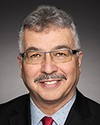I think it's understanding what your population is. I'd be happy to send you all of our responses back to COSEWIC that question the data that's being pulled before these listings because there's certainly been more than just a handful of cases. I'll be happy to forward that to you.
Any time an environmental assessment is done, just as an example, there's the population, demographics, and a profile of a number of different species, which are provided as baseline data. None of that data is ever compiled. We've had a dozen environmental assessments from various projects that have gone in. There is no compilation of the data. It sits in isolated pockets. It should be compiled by a government, so everything is available for everybody to see and use. That has not been done. We undertook the effort actually to pay to have that done, particularly for the caribou, and submitted it to Environment Canada. These were all environmental assessments that were done. Environment Canada refused to accept that data.
These are some fundamental things that shouldn't happen. They are all science-based. They're done by consultants who are professional in their work. We need good data and we need good databases in order to make good decisions. We see things in silos right now rather than integrated, and I'm sure Saskatchewan is not alone in that. I'm sure if you tried to find a comprehensive database for other species in other areas, you would have the same issue. I think there certainly could be some collaboration amongst the jurisdictions in developing and sharing databases.
The caribou recovery strategy plan was based on a model for caribou populations in Quebec. It had nothing to do with Saskatchewan. It had to do with linear developments that came from Alberta, where you had intensive oil and gas disturbance, and you needed a 500-metre buffer in terms of linear disturbance.
The fellow who is in charge of that study, Dr. Phil McLoughlin, said it was inappropriate to use that buffering in northern Saskatchewan because it was not the same type of disturbance. We have 3% man-made disturbance in northern Saskatchewan. We have a fire regime that causes over 45% natural disturbance, which is natural. According to Environment Canada's recovery strategy, they don't want to let any development happen with anything more than a 35% disturbance.
When you have a fire regime that's 45%, which happens on a more regular basis than 40 years, how are you going to have any sort of development? We know our caribou populations are there. Under Environment Canada's model, theoretically there would be zero caribou in northern Saskatchewan. We know that there is a healthy population. Their model is wrong. They need to realize that.




